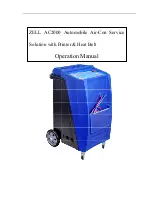
Section BXM‐10N‐HE5‐20A
030‐101815 Rev. A
R
15
1402IARA
Figure 19. Field Replacement of Fans
Inside-air fans
Wired to FAN B connector
Loosen
remove
nuts to
fans
Loosen hex nuts
to remove fans
Outside-air fans
Wired to FAN A
connector in
Controller Card
in Controller Card
(2 wires for each fan,
join same-colored wires together
from each fan prior to insertion
into connector in controller card)
10.
Remove fans.
Lift the old faulty fan off the mounting studs.
11.
Store bracket.
Replace the bracket and thread the wing‐
nuts back onto their posts.
12.
Return fans.
Return the fan(s) to Westell for repair or re
placement (see Paragraph 7.2).
13.
Install replacement fan(s).
Mount the replacement fan(s)
onto their mounting studs and reverse the steps above, and
also read the note below to secure the fan(s) and make
wire connections. Route the twisted fan wire through the
ferrite toroid in the same manner as the other wires are
routed, two turns.
‐ FAN WIRING IN EURO‐CONNECTOR NOTE ‐
One euro‐connector serves two fans: there is one connector for
the two external air fans (connector labeled “FAN A”) and one
connector for the two internal air fans (“FAN B”). Each fan has
a black wire and a red wire. When wiring a new or replacement
fan, the same colored wire from each fan should first be twisted
together as a single wire unit prior to insertion into its proper
termination hole in the connector.
14.
Apply power and test.
If not already installed, re‐install the
fuse in the controller card, and apply power to the cabinet.
Verify the fans are working properly by pressing the fan
test button (see Figure 16 for location).
5.3
Replacing the “Inside Air” Fans
Fans cannot be field
repaired
. Should a problem be suspected
with an “inside air” fan, remove the fan and return it to Westell
for service, then
replace
it. See Table 4 for ordering informa
tion. To remove and replace an “inside air” fan, proceed with
the following instructions.
‐ CAUTION ‐
To avoid electrical shock, turn off any DC or AC power feeds
to the controller before beginning this procedure.
1.
Open the cabinet.
Open the cabinet door by loosening the
two cup‐washer screws with a can wrench or 216 tool.
2.
Remove fuse.
Remove the 5A fan fuse from the controller
card (see Figure 9 or Figure 16 for fuse location).
3.
Disconnect fan power.
Disconnect the FAN B connector at
the controller card.
4.
Remove wires from connector.
Remove the red and black
wires from the connector. Make a note of which wires (red
or black) were inserted into which holes in the connector.
5.
Replace connector.
Insert the empty connector back into the
controller card, remove the fan wires from the ferrite toroid,
and note the directions the wires are wrapped through the
toroid.
6.
Verify fan is off.
Visually check to ensure that the fan blades
are NOT rotating.
7.
Remove fan mounting nuts.
Remove the nuts that secure the
fans to the inside of the cabinet door.
8.
Remove fans.
Lift the old fans off their mounting studs.
9.
Store nuts.
Replace the nuts back onto their posts.
10.
Return fans.
Return the fan(s) to Westell for repair or re
placement (see Paragraph 7.2).
11.
Install replacement fan(s).
Mount the replacement fan(s)
onto their mounting studs and reverse the steps above, and
also read the note below to secure the fan(s) and make wire
connections. Route the twisted‐pair wires through the ferrite
toroid in the same direction as the other wires, then connect
to the Euro connector.
‐ FAN WIRING IN EURO‐CONNECTOR NOTE ‐
One euro‐connector serves two fans: there is one connector for
the two external air fans (connector labeled “FAN A”) and one
connector for the two internal air fans (“FAN B”). Each fan has
a black wire and a red wire. When wiring a new or replacement
fan, the same colored wire from each fan should first be twisted
together as a single wire unit prior to insertion into its proper
termination hole in the connector.
12.
Apply power and test.
If not already installed, re‐install the
fuse in the controller card, and apply power to the cabinet.
Verify the fans are working properly by pressing the fan
test button (see Figure 16 for location).
5.4
Replacing the Door Alarm & Fan Cut‐off Switch
The door sensor switches cannot be field repaired. Should a
problem be suspected with the door sensor switch, remove the
entire door alarm switch assembly and return it to Westell for
service, then replace it. To remove and replace the door alarm
switch assembly, proceed with the following instructions.
‐ WIRE AND BLOCK DISCONNECTION NOTE ‐
The Euro‐connector blocks used for making DC distribution and
alarm wire connections facilitate a simple group disconnection of
all alarm and dc distribution wire connections; there's no need to
unscrew each wire. Simply remove the entire block by pulling the
blocks away from the panel.







































